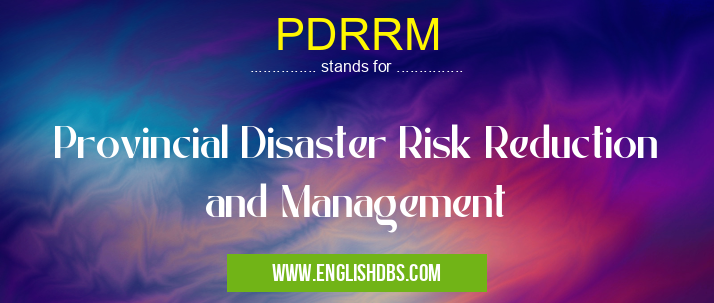What does PDRRM mean in MANAGEMENT
Provincial Disaster Risk Reduction and Management (PDRRM) is an important tool for ensuring the safety, security and resiliency of communities in the aftermath of natural disasters. PDRRM seeks to reduce the impact of disasters through prevention, preparedness, response and recovery efforts. This includes developing policies and strategies to reduce the risk of disasters and improve community recovery capabilities.

PDRRM meaning in Management in Business
PDRRM mostly used in an acronym Management in Category Business that means Provincial Disaster Risk Reduction and Management
Shorthand: PDRRM,
Full Form: Provincial Disaster Risk Reduction and Management
For more information of "Provincial Disaster Risk Reduction and Management", see the section below.
» Business » Management
Essential Questions and Answers on Provincial Disaster Risk Reduction and Management in "BUSINESS»MANAGEMENT"
What is PDRRM?
PDRRM stands for Provincial Disaster Risk Reduction and Management. It is an approach to mitigating the effects of natural disasters on communities by creating policies, strategies, and resources that can help prevent disaster-related damages, prepare for potential risks, respond to urgent threats, and recover from crises.
How does PDRRM work?
PDRRM works by taking a proactive approach to reducing disaster risk in a given province. It involves developing policies that aim to address existing risks as well as identifying factors that could potentially lead to future disasters. Strategies are also developed to ensure effective emergency management systems are in place so that people can be quickly evacuated from dangerous situations when necessary. Finally, resources like early warning systems, communication infrastructure, and relief funds are put in place to help with protection during emergencies and aid with recovery efforts afterwards.
Who is responsible for implementing PDRRM?
Depending on the province or region, implementation of disaster risk reduction measures may be handled by local governments or other authorized organizations such as emergency services departments or civil defence units. However, governments should coordinate closely with various stakeholders including non-governmental organizations (NGOs), international organizations/institutions like United Nations Development Program (UNDP) as well as relevant partners at regional national levels.
What kind of resources does PDRRM provide?
Resources available through PDRRM typically include early warning systems for hazard alerts; plans for evacuation; access to emergency shelters; means for communicating warnings; training materials that teach people important skills such as first aid; medical facilities; access to food supplies during an emergency; search & rescue teams; access to financial assistance funds; damage assessment mechanisms; safe disposal of waste systems following an incident; damage repair funds; access to insurance coverage programs and more.
What are some examples of successful implementations of PDRRM?
Successful implementations of PDRRM have been seen in many countries around the world such as Japan's extensive earthquake preparedness plans which include both micro-level preparedness activities such as community education campaigns as well fiscal commitments from both central government finance programs in order support further disaster reduction initiatives such as those implemented by local governments after typhoons hit vulnerable regions like Okinawa in 2020. Other examples include Chile's widespread risk identification system which uses special alert codes known ‘Orange Alerts†over radio broadcasts when hazardous events occur along with implementation strategies used by Philippine government following Super Typhoon Haiyan in 2013 which included resource relocation strategies under the Tubungan Barangay Revitalization Program post-disaster recovery scheme.
Final Words:
Overall, Provincial Disaster Risk Reduction and Management plays a vital role in helping communities prepare for potential risks associated with natural disasters so they can better handle them if they arise while also providing valuable resources that allow people affected by crises recover more quickly afterwards. By understanding what steps provincial governments can take towards reducing their citizens' exposure to risks associated with environmental hazards before it's too late we can all work together towards saving lives whenever possible.
